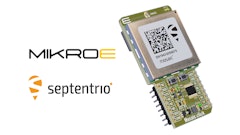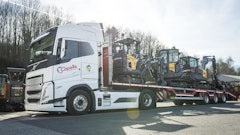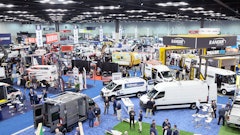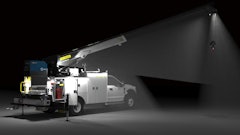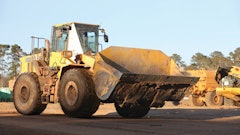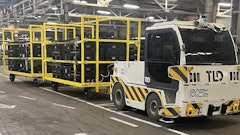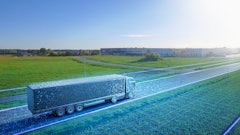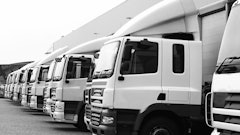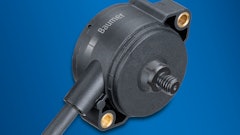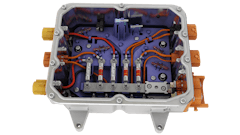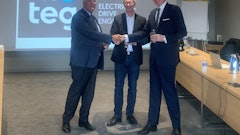
responses submitted by Eric Neal, Executive Director, Cummins Off-Highway Business
Global Markets, Government & Trade
What are the key global markets your company sees as growth opportunities and why?
The off-highway business is very global in nature with a wide variety of customers and machine applications. As agriculture and construction OEMs seek higher differentiation through technology, many of them will seek partnerships with companies like Cummins. We can help them with the appropriate technologies, backed by our global engineering, manufacturing and service capabilities.
How would passage of an infrastructure or other similar bill in the U.S.—or the equivalent in other countries—benefit the industry?
With Cummins off-highway being truly global, infrastructure bills almost anywhere represent good opportunity. Building of roads, bridges, city expansion, etc. are all construction equipment dependent. The current outlook would suggest that beyond 2020 the overall construction market will begin to see recovery from the current low point. Major infrastructure developments could easily change the slope of that recovery period.
Impacts of COVID-19
What have been some of the biggest challenges your company, and the industry as a whole, has faced due to the COVID-19 pandemic?
The major challenge that everyone has faced is the aspect of how to maintain operations in a safe manner. Our people are the most valuable resource of all for which we carry the duty of protecting. Learning how to adapt to remote work for those who could, and how to adapt manufacturing facilities to promote social distancing were steep curves. We have managed these successfully and returned productivity close to pre-COVID levels.
Have the challenges brought to light any potential opportunities for change or improvement within your company, or the industry?
Cummins has used its filtration expertise to partner with DuPont and support the manufacturing of face masks to aid the COVID19 situation.
What, if any, long-lasting effects do you think the pandemic could have on the industry?
Business-to-business interactions may never fully return to how they were pre-COVID. I think many companies have quickly grown comfortable and efficient leveraging online tools for daily interactions. This by no means devalues the face-to-face aspect of building relationships, however it makes everyone look at travel more critically moving forward.
How do you foresee the industry coming through this?
Slow and steady. 2020 pre-COVID was expected to be down from 2018/2019 highs and COVID amplified that demand weakening. Looking forward in time we expect the market to steadily climb back up through at least the 2023 time frame. Regional ebbs and flows are to be expected due to normal, non-COVID dynamics but overall a steady climb.
Diesel, Electric & Other Power Alternatives
What opportunities for technology and efficiency advancements still exist with diesel engines?
A consistent message we convey is that we see diesel being around for many years to come, we also expect it to become cleaner and more efficient. Diesel also meets specific power requirements for customer needs that current alternate technologies are not able to competitively meet. Power density increases should continue to be expected out of diesel, just look back at EPA Tier 3 product output by displacement compared to our latest Performance Series engines today.
Major improvements have been made and there is no reason to expect engineering to slow down now. Emissions reduction is still possible with technologies coming from the on-highway sector focused on reducing NOx output and other constituents. Efficiency gains will be realized through downsizing opportunities, smarter powertrain integration, wider adoption of features like Start/Stop, etc. Diesel still has a long runway and many exciting future advancements should be expected.
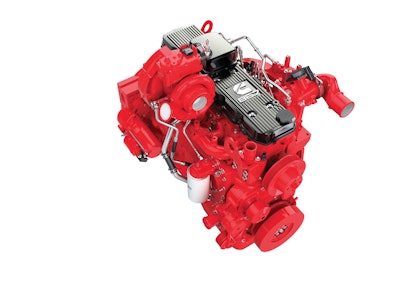 The B6.7 Performance Series engine.Cummins Inc.
The B6.7 Performance Series engine.Cummins Inc.
How does your company see alternative fuels playing a role in the heavy equipment industry in the coming years?
At this point, our on- and off-highway engines meet and exceed the very latest regulations and can be used in the ultra-low emissions zones such as London. There is a real impetus to have low emission areas in ports and inner-city areas that will drive the need for more alternate power and is why Cummins is investing in a wide range of new power solutions to be ready for this.
Cummins' strategy is to understand all emerging power sources in the future and offer the most appropriate one for each customer and machine. In addition to advanced diesel technology and various forms of electric power, we are exploring other power sources such as fuel cells, gasoline, natural gas and other technologies.
It is our expectation that adoption of alternate power will be a slow ramp rate with electrification of compact equipment probably the nearest term. There is no doubt a lot of excitement in the industry for technology like electrified power, and will continue to be, it’s just a matter of keeping a pulse on the drivers that will pull the technology mainstream.
What role is electrification—or other alternative energy/power systems—playing in your company’s design initiatives?
Cummins' initiatives are initially focused on the applications that are the most aggressive in electrification adoption. The bus market has been strong in adoption, but in off-highway we are designing for applications that operate in ports or distribution terminals such as terminal tractors. There is also a tremendous amount of interest in excavators and other earthmoving equipment and Cummins is positioning to be an electric powertrain provider there as well. Electrification will eventually play a bigger role in the future and be more broadly adopted when the Total Cost of Ownership (TCO) becomes more competitive with diesel. Subsidies and/or incentives to purchase zero-emission products will be needed to enable wider adoption.
Are there any emissions or other related regulations your company is monitoring, or feel will have an impact on design efforts and the industry?
The next big hurdles in global off-highway emissions will be the implementation of China Stage IV and India Bharat Stage 4. The good news for Cummins is that we have existing technologies and experiences based on some of our on-highway markets that will bring scale and value to our solutions to meet these areas. Looking further out, we do anticipate some global emission convergence which again brings opportunities to Cummins to build scale in our design and manufacturing.
READ MORE: State of the Industry 2020
Data, IoT & Connectivity
How will the role of the Internet of Things (IoT) and data continue to progress in the coming years?
Transformations realized through digital in the next 5-10 years will be significant. End users will have expanded access to operational data to enable jobsite decisions. Equipment OEMs will have access to equipment usage to better tailor design. Powertrain component suppliers will have unprecedented access to information that enables smarter design and quality improvements. The forefront of digital will net improved uptime and allow streamlined maintenance and repair execution for a positive customer experience. Simple tasks like machine calibration changes will move from physical connection to remote allowing work to be carried out at convenient times on the job site. Through connectivity even maintenance intervals themselves will become smarter, leveraging machine duty cycle information to maximize intervals and improve customer total cost of ownership. Cummins is actively developing these capabilities and working alongside our partner OEMs to deliver these to our end customer base.
Do you see a path toward the use of artificial intelligence (AI), virtual reality (VR) or augmented reality (AR) in your manufacturing processes, or even on-board the vehicle itself?
At a powertrain supplier level we have looked at these technologies for the future to change the way we train technicians to service equipment. AR as displayed at previous tradeshows offers the opportunity to train technicians with the absence of hardware; longer term it has the potential to aid technicians remotely to walk through complex repairs on a jobsite. This type of technology can enable efficient and accurate repairs, ensuring the job is done right the first time out. With powertrain diversity increasing, having the ability to directly support technicians in the field offers great potential.
How do you see connectivity and machine learning changing the vehicle landscape in the next decade?
Machines will continue to get smarter supported by connectivity. Skilled labor is difficult to find, and smarter machines can go a long way towards addressing that challenge. Infrastructure needs around the world will continue to be of high demand, project complexity will continue to increase, and if left without connectivity inefficiencies would probably rise. For certain basic connectivity to feed operator information on dig depths, grades, etc. will be commonplace. Having visibility to machines and operation details will also help ensure contractors have the right equipment on any given jobsite, potentially altering purchase mix of equipment types. Through operational data visibility equipment will become more reliable and any downtime more predictable. Through this it is reasonable to expect equipment will be better kept, either lengthening the first ownership time period or leading to increased resale value compared to today.
What challenges remain or lay ahead for the continued adoption of data, IoT and connectivity related technologies or systems?
Data can be overwhelming, it is up to OEMs and powertrain suppliers to strive to provide insights over just information. Turning data into direction is the key challenge to making this work to the optimal level. Another major challenge is that most fleets have a range of different OEM machines. Consistency of data across the fleet is needed for the operational team to make efficient use of it. Last but not least, data privacy laws must be navigated, which vary by region of the world. Capability must always be crosschecked with legality so it is possible that some opportunity could be left on the table along the path.
Automation & Smart Systems
What impacts are you seeing automation playing on the heavy equipment and vehicle industries?
With labor shortages and increased demand for food, we see a growing demand for automation in agriculture. Cummins has already powered equipment for the agricultural industry with our clean performance series engines, with a couple of examples being GUSS and DOT.
READ MORE: The Orchard Worker of the Future
In the construction sector the skilled labor pool is a significant challenge. Features such as grade or dig assist take some of that special skill requirement from the equation. The next generation of equipment operators will understand computer and video technology. They will use this on site or even remotely to work the machinery. Taking the concept of an operator in a room, coupling it with the fact that not all equipment operates at the same time on any given site, and it is possible one operator can easily manage multiple equipment pieces daily.
Automation will also serve as a vehicle to reduce risk and improve health and safety. Equipment operated underground is a dangerous environment and could be operated from surface level in the comfort of a chair.
What is needed to further progress equipment and vehicle automation?
Connectivity is the predecessor, information enables automation. There are case studies which can be found easily that demonstrate how this progression plays out in practice. From a powertrain perspective connectivity enables operation data to help ensure an unmanned piece of equipment can identify and flag any issues before they become mission disabling or progressive damage is experienced. Tying back to an earlier response, this is where turning data into insights becomes critical.
How do you see inclusion and development of telematics systems continuing to progress in the 5-10 years?
We anticipate that there will be ongoing operations needs and technology improvement responses utilizing telematics to improve the overall efficiency of their operation and the way we connect with customers.
Challenges & Opportunities
What are the biggest challenges facing the industry currently, or do you see the industry facing in the coming years?
A key challenge is the changing emissions landscape around the world. Traditionally lagging countries such as China and India will make huge leaps to European/U.S. level technologies. This will introduce new technologies into areas which have not experienced things like aftertreatment systems in the construction space before. Cummins has significant global experience in both on- and off-highway emission technologies to support our customers through this.
What are some of the biggest opportunities you see in the industry?
As a global powertrain supplier Cummins has great scale and a robust technology stable to pull from. With emissions varying across major markets, and with alternative power projects taxing OEM engineering resources, we believe our power will be well positioned to support OEM needs. Our diverse product line and technology base will enable our partners to focus on machine level needs and rely on Cummins for power in whatever form it may be.
Are there any technologies or trends which you are currently excited about in the heavy-duty vehicle industry, or most looking forward to seeing in the coming years?
The answer is many. Alternate power absolutely is exciting, and we are building our portfolio at a rapid pace. Diesel continues to be exciting, with so many potential levers to pull. There are more big things to come for internal combustion. Finally, digital connected solutions tools provide real opportunity to impact the end-user experience and help our OEM partners create pull for Cummins powered equipment.











